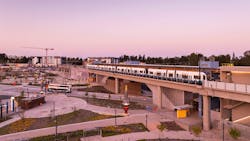Two recently opened transit projects are reshaping mobility and access on the West Coast in the U.S. Seattle’s 8.5 mile Lynnwood Link Extension and the Bay Area’s 51 mile Caltrain Electrification Project demonstrate the power of transit investments to improve quality of life and set the stage for a more sustainable and connected future.
“Great transit systems are a commonality of the world’s most iconic cities,” said Pranaya Shrestha, senior program manager for HNTB, which served as owner’s representative for the Caltrain project. “They also are vital parts of great communities. We see projects as more than simply moving people safely from point A to point B. They are delivering a significant return on investment, bringing people together and providing economic, health and leisure opportunities that are critical for communities to be successful.”
Powering the future of Caltrain
The transformational Caltrain Electrification Project moves the San Francisco Peninsula toward modernized, faster, sustainable public transportation. Electrified service on the 51-mile corridor from San Francisco to San Jose, Calif., began Sept. 21, 2024.
The electrification improves Caltrain system performance and curtails environmental impacts by reducing noise, improving regional air quality and lowering greenhouse gas emissions. The electric trains, powered by renewable energy, will reduce annual emissions by a projected 250,000 metric tons of carbon dioxide per year, the equivalent of taking 55,000 cars off the road.
“This project represents a leading-edge change that has gained attention locally, nationally and even internationally,” Shrestha said.
“Caltrain’s Electrification is a transformative leap forward for our community and every rider who will benefit from these advancements,” said Caltrain Executive Director Michelle Bouchard. “We are running a faster, greener, across-the-board better system than any time in the 160-year history of our corridor and the Bay Area will reap the rewards of this project for decades to come.”
Throughout construction and consistent with Caltrain’s goals, the project team minimized inconvenience to corridor passengers by keeping existing service in place and scheduling construction during overnight hours and weekends.
The project team installed foundations, pre-engineered poles and millions of feet of wire to support the overhead contact system (OCS) that powers Caltrain’s fleet of high-performing electric trains. Additionally, 10 traction power facilities — electric power stations that distribute and regulate electricity to the OCS and electric trains — were installed on the corridor.
The power upgrades will also accommodate California high-speed rail trains when they are ready, allowing riders to step off a Caltrain vehicle and onto high-speed rail to travel further south.
As part of its signal system upgrade, Caltrain implemented wireless grade crossing technology that improves warning time consistency. When wireless crossing is enabled, Caltrain’s Positive Train Control-equipped electric locomotives facilitate constant warning times at the crossing based on the train’s GPS position and speed.
Electrification of the line also delivers faster, more frequent service for passengers, including doubling service on weekends. Caltrain’s seven-car electric trainsets maintain operating speeds up to 79 mph, zipping between San Francisco and San Jose in less than an hour. Service to stations increased by 20 percent, with trains arriving every 15 to 20 minutes during rush hours at most stations and every 30 minutes during weekends, midday and evenings.
The train cars are equipped with roomier seats, free Wi-Fi, electrical outlets under every fixed seat and expanded storage capacity. Each train includes an ADA-compliant restroom and two bicycle cars. CCTVs in the train cars enhance safety and the electric trains provide a quieter, more comfortable rider experience.
Within the Bay Area, Caltrain’s new electrified corridor will serve as a key component of the region's interconnected transportation network. The Santa Clara Valley Transportation Authority and Amtrak will connect with Caltrain at San Jose Diridon Station while Bay Area Rapid Transit provides a direct link to San Francisco International Airport via Millbrae Station.
The electrification of Caltrain’s San Francisco-San Jose corridor offers communities a more sustainable and efficient transportation solution. Shrestha expects the project to also serve as a model for rail transit modernization throughout the country.
“Just as our country moved from steam to diesel, electric corridors are the next big step,” Shrestha said. “In the years ahead, we’ll see diesel move toward electrification and Caltrain is leading that effort.”
Lynnwood Link’s impact on Seattle’s North
Part of one of the largest transit expansion programs in the country, Sound Transit’s transformative Lynnwood Link Extension opened at the end of August 2024.
“This new service marks the first time Sound Transit’s Link light-rail system has extended into Snohomish County, broadening the range of the entire line and connecting communities across the region,” said Snohomish County Executive and Sound Transit Vice Chair Dave Somers. “The Lynnwood Link Extension provides an efficient and sustainable transit option and brings numerous benefits to the region by enhancing daily commutes, reducing environmental impact and fostering economic development.”
The new line serves the Shoreline, Mountlake Terrace and Lynnwood communities, connecting them directly to Seattle’s urban core, the Seattle-Tacoma International Airport and beyond. As project manager, HNTB provided construction support for the extensive, multiyear project, which incorporates four new stations and three new parking garages.
The Lynnwood Link Extension delivers a fast, frequent and reliable connection for riders through some of the heaviest traffic congestion in the state of Washington.. Running parallel to Interstate 5, the Lynnwood Link alignment minimized the line’s construction footprint and allowed gentle curvature on wide curves, permitting a maximum operating speed of 55 mph..
By design, the project team minimized traffic impacts during construction. Where the extension crosses I-5 north of Mountlake Terrace, the original design called for a cast-in-place, balanced-cantilever long-span bridge to be built over the interstate. To deliver a more cost-effective bridge, the project team instead used falsework to facilitate construction of a more conventional cast-in-place box structure. A section of the bridge was precast in Tacoma, Wash., while the other sections were poured in place due to the structure’s curved shape.
The urban environment also drove creative designs at the stations to accommodate bus transfer facilities and parking garages. Beyond improving mobility, the extension enhances quality of life throughout the region. It is expected to serve approximately 40,000 daily riders, providing reliable alternative transportation while creating access to services and economic opportunities and promoting sustainable urban growth.
Local transit agencies have added bus feeder networks at each station that spread the benefits of light rail across a wider area. The line’s four new stations have already spurred nearby transit-oriented development. Roughly 10,000 housing units have been added or are being developed near the four stations.
Trains are expected at the stations every eight minutes at peak times on weekdays and every 10 minutes in the evenings and on weekends. In the next few years, Sound Transit plans to begin work on the line’s next phase to the north, a 16-mile connection from Lynnwood to Everett.
“The Lynnwood Link Extension project stands as a testament to the ability to deliver complex infrastructure on time and on budget through effective collaboration and strong relationship management,” said HNTB Project Manager Moein El-Aarag. “Together, Sound Transit, [Washington State Department of Transportation], the project team and the cities of Lynnwood, Mountlake Terrace, Shoreline and Seattle have achieved a significant milestone in enhancing the region’s transit infrastructure.”
About the Author

Suze Parker
Public Relations Consultant and Writer
Suze Parker is a public relations consultant and writer who frequently writes about transit and other infrastructure projects.
